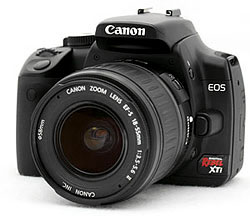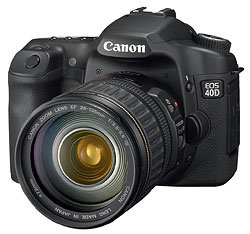Five reasons you need a digital SLR
by Shawn Barnett
Posted: 11/20/07
I'll start out by saying that not everyone needs a digital SLR, but if you were attracted to this article, chances are you've been seeing more digital SLRs out there and have wondered how owning one might improve your photography.
What does an SLR have that your digicam doesn't? That's an important question, because SLRs are a little more expensive, bigger, and heavier than the average digicam. And you can often get more zoom and resolution in a slim pocket camera than the average consumer digital SLR kit offers. So what's the benefit?
The answers are simple, but not obvious if you haven't owned an SLR before. I've narrowed them into five categories. Put simply: Digital SLRs are faster, work better in low light, have better optics, are more versatile, and yet are very simple to use. That last item is less a reason than a reassurance. People are too often intimidated by an SLR. Even the name, which stands for Single Lens Reflex, sounds scary. But modern technology has made the digital SLR camera as easy to use as a point-and-shoot digicam.
SLRs are faster

Canon Digital Rebel XTi
With a full-autofocus shutter lag of 0.2 second, the Canon Rebel XTi is among the faster digital SLR cameras on the market. It also has an excellent AF system that's good in low light, is capable of up to 1/4,000 second shutter speeds and capturing three frames per second. It's great in low light, and in brighter light its images are stunning. See our review of the Canon EOS Rebel XTi.
Res: 10mp
Zoom: 3x
Storage: CF, MicroDrive
Compare Price (kit): $617-900
Compare Price (body): $553-800
Low: $609.99
Avg: $687.84
Click Here for best prices!
Your shopping clicks support this site, help keep the reviews coming!
If you've owned a "regular" digital camera (I'll call them digicams), you've experienced the disappointment of looking at the LCD, seeing a great moment, pressing the shutter button and emphatically not getting what you saw on the LCD. That cute smile turned to a frown, or the child turned his head, or left the room altogether. Had the camera taken the shot when you pressed the button, you'd have had the greatest picture! That's called Shutter Lag. All cameras have it to some extent, including SLRs; but digicams are generally slower.
There are several elements to the shutter lag problem.
Human lag. The first delay actually starts with you. It takes time for the message to travel from your brain, down your arm to your finger, and then the muscle has to contract and press the button. This lag obviously isn't the camera's fault, but with you already lagging, you need all the help you can get from your camera.
Display lag. Most people don't think about it, but it takes time for your LCD to display what's happening in front of your lens. If you're looking at the LCD, you're seeing exactly what you'll capture, but with a slight delay.
Look through the optical viewfinder of an SLR, however, and you're getting the actual light through the actual lens that your camera will use to take the picture, straight into your own eye at the speed of light. No waiting. You can't get faster than that.
Shutter lag. When you press the shutter button, today's modern digital cameras go through quite a dance, usually in less than a second. They look at the scene and try to find the most likely subject, then they move the lens to find the greatest contrast to set focus, then they set the exposure, and finally take the picture. If the flash is on, they first fire a preflash to check the exposure, and then they take the picture. It's really quite amazing, because the computer technology in these cameras is achieving in under a second what used to take photographers many years to master, and many seconds, sometimes minutes to set; especially flash exposure. But when you want the shot, you want all of that to happen as fast as possible, and SLRs have a speed advantage.
Focus lag. By far the longest lag time is due to the camera's attempt to interpret the scene and find focus. I won't go into all the details about how the two different methods work, except to say that digicams use a very effective method called contrast detect, and SLRs use an older method called phase detect, which is usually quite a bit faster. Phase detect is more like the old SLRs used to use, where you turned the focus ring until two parts of the image matched up in a split-prism in the viewfinder. Most SLRs are a good deal faster at phase detect than digicams are at contrast detection. We test the autofocus lag here at Imaging-Resource.com, and the difference is usually significant, taking about half to three-quarters of a second on most digicams and more like one-quarter second or less on SLRs.
Zoom time. As I was preparing to write this, I asked my nine-year-old daughter why she would want a digital SLR instead of her digicam. Once I explained what an SLR was by waving the one I was holding, she blinded me with the lightbulb that went on over her head: "Oh, so I can zoom without having to press a button and wait." That's my girl. She learned that by using Dad's digital SLR, not by anything I've told her.
Indeed, the motorized zoom mechanism has to be one of the slowest elements of a digicam. Worse, most only move in broad steps, and the framing often changes once you stop zooming and try to focus. It can be quite maddening, so much so that I often zoom with my feet at that point, stepping back or forward a little to get my framing just right. With an SLR's zoom lens, zoom is mechanical, so you can fine-tune your framing with both speed and precision by just turning the lens barrel.
Shutter speeds. Of course, shutter speeds are also faster with a digital SLR, with most delivering either 1/4,000 or 1/8,000 second maximum shutter speeds, which allows you to better freeze action. It also lets you shoot at wider apertures in bright daylight, to decrease the depth-of-field and isolate your subject from its background, which is great for sports or portraits. Most digicams max out at 1/2,000 second, many at 1/1,000 second.
Finally, many external SLR flash systems will allow you to sync your flash all the way up to 1/8,000 second by pulsing rapidly during the exposure (called FP mode), which again allows for fill flash with blurred backgrounds in broad daylight.
Shot-to-shot speed. Most digital SLR cameras are capable of capturing at least three images per second, provided the shutter speed is fast enough. Higher-end cameras can do five, six, and even eight frames per second. Most digicams can deliver between only one and two frames per second at their full resolution. It's not a big deal until you're trying to capture action, but an SLR is what you need for action photography because if its superior speed in so many ways.
SLRs work better in low light

Canon EOS 40D
The 40D's full-AF shutter lag is even better than the XTi, at 0.128 second. But the big story is the 40D's low light performance. We haven't seen many cameras that will focus in the lowest light levels we test at, and the 40D's high ISO image quality is tough to beat. It has a Live View mode for composing with the LCD if you choose, and can fire at 6.5 frames per second. The 40D is shown here with the 28-135mm IS kit lens, an image-stabilized lens that is quite a bit better than most kit lenses. There are so many other impressive features on the 40D, we recommend that you see our review of the Canon EOS 40D for the full story.
Res: 10mp
Zoom: 4.8x
Storage: CF, MicroDrive
Compare Price (kit): $1,360-1,500
Compare Price (body): $1,180-1,300
Though cameras are tasked with preserving our memories, they don't see in quite the same way that we do. Our brains work with our eyes to compensate for changes in light, both the color of the light and its intensity; and because what we see is more like video than snapshots, our brain can work to fill in details with images captured over time, while a camera has only one short moment to work with. So it's really no surprise that people are disappointed when they can't seem to get their expensive new digital camera to take a decent picture at their son's wrestling match. It sure seems bright enough in there, but unless you get to within eight feet and use the flash, what you come away with will be yellow and blurry.
The truth is that your camera is doing the best it can in a very low-light situation (something you'll know for sure if you step out from the gymnasium and into a bright, sunny day: your eyes adjust quickly, but those first few seconds really hurt). And here is where an SLR has it over a digicam: its sensor is much bigger than the tiny sensors in most digicams, which means it's going to be better in low light.
Light Sensitivity. A bigger sensor makes for bigger pixels. Bigger pixels mean more light can hit each pixel, and the camera can make a better decision about what color and intensity to assign each pixel when it builds the final image. In other words a digital SLR camera can gather more light, more quickly, and with less error than a small digicam can. All of which adds up to a better, more detailed shot of your son in the stadium, your daughter at the recital, and your family in the living room. You'll still have to hold very steady, maybe use a stabilized lens, and shoot a lot of pictures to avoid blur, but you'll have much better chances with an SLR for just about any kind of sports or entertainment photography than you do with a digicam.
Autofocus. Most digital SLRs can also focus better in low light, thanks to their dedicated AF sensors. Digicams usually use the image sensor to do their contrast-detect autofocus. In low light, we know that each of these tiny pixels is already struggling to gather enough light to determine what it's seeing, so the autofocus system has less information to work with when running its contrast-detect function.
Optics. Because it's an SLR, you can gain speed by attaching a "fast" lens. This is a lens with a lot more light gathering ability than most kit lenses. You can tell a fast lens by its maximum aperture number, usually stated right after the focal length. The closer the number is to 1.0, the faster it is. A 50mm f/1.8 lens has four times the light gathering power of an f/3.5 kit lens.
[an error occurred while processing this directive]